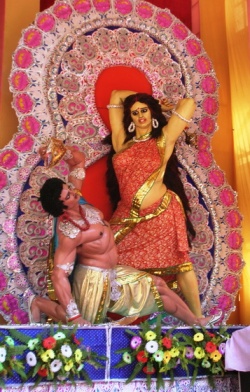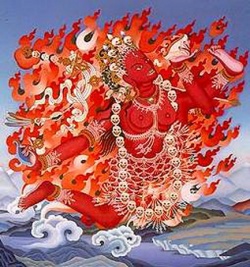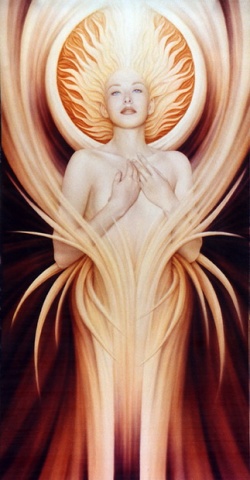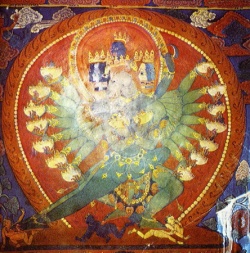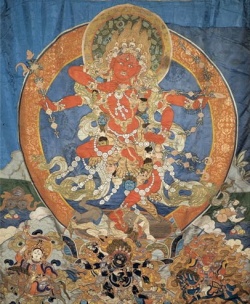Difference between revisions of "Dakinis"
(Created page with "The Jatakas (stories of Buddha's former lives) contain several incidents in which divine beings are described as traveling through the air. In Sanskrit, such a being is calle...") |
|||
| Line 1: | Line 1: | ||
| + | [[File:Dakini_Fatakeshto.JPG|thumb|250px|]] | ||
The Jatakas (stories of Buddha's former lives) contain several incidents in which divine beings are described as traveling through the air. In Sanskrit, such a being is called a dakini, a term generally translated "space-goer," "celestial woman," or "cloud fairy." All these phrases, and more besides, are used to translate the word dakini into English. (The -ini ending is not a plural, but a feminine word ending.) | The Jatakas (stories of Buddha's former lives) contain several incidents in which divine beings are described as traveling through the air. In Sanskrit, such a being is called a dakini, a term generally translated "space-goer," "celestial woman," or "cloud fairy." All these phrases, and more besides, are used to translate the word dakini into English. (The -ini ending is not a plural, but a feminine word ending.) | ||
In Chinese, similar meaning is preserved in K'ung-hsing fo-mu. | In Chinese, similar meaning is preserved in K'ung-hsing fo-mu. | ||
| Line 13: | Line 14: | ||
In Chinese, similar meaning is preserved in K'ung-hsing fo-mu. | In Chinese, similar meaning is preserved in K'ung-hsing fo-mu. | ||
In Tibetan, the word for Dakini is khandroma (spelled mKha-gro-ma.) When used as a personal name, it is Khandro, pronounced as written in English. In Tibetan liturgy, it is pronounced kha'dro. | In Tibetan, the word for Dakini is khandroma (spelled mKha-gro-ma.) When used as a personal name, it is Khandro, pronounced as written in English. In Tibetan liturgy, it is pronounced kha'dro. | ||
| + | [[File:Dakini_rose.jpg|thumb|250px|]] | ||
In Tibetan, the mkha' syllable means sky but also ether, or space, and space in the context of Buddhism is related to Emptiness. That term can be understood to refer to the potential for Enlightenment inherent in sentient existence. The gro part meaning moving or going, in the same context connotes mastery in the sense of "knowing with complete understanding." The ma ending is a female indicator. | In Tibetan, the mkha' syllable means sky but also ether, or space, and space in the context of Buddhism is related to Emptiness. That term can be understood to refer to the potential for Enlightenment inherent in sentient existence. The gro part meaning moving or going, in the same context connotes mastery in the sense of "knowing with complete understanding." The ma ending is a female indicator. | ||
The heavenly realm or "pure land" of dakinis is called Khechari. | The heavenly realm or "pure land" of dakinis is called Khechari. | ||
| Line 26: | Line 28: | ||
Himalayan Buddhism is a system known for its wonderful and rich symbolism, and the Dakini is one of its most mysterious and complex figures. Here, a non-discursive experience of "ineffable reality" is given form. So dakini stands for a visitation of what, in other systems, might be termed Divine Grace. | Himalayan Buddhism is a system known for its wonderful and rich symbolism, and the Dakini is one of its most mysterious and complex figures. Here, a non-discursive experience of "ineffable reality" is given form. So dakini stands for a visitation of what, in other systems, might be termed Divine Grace. | ||
| − | + | [[File:Dakini478.jpg|thumb|250px|]] | |
Janice D. Willis, in Feminine Ground, explains her as "the supreme embodiment of the highest wisdom itself." | Janice D. Willis, in Feminine Ground, explains her as "the supreme embodiment of the highest wisdom itself." | ||
In English, dakinis have been called everything from "furies" to "fairies," and this points to the development of two layers of meaning: the evolution of Buddhism from its cultural context, and the increasing sophistication of the West with regard to Buddha Dharma. | In English, dakinis have been called everything from "furies" to "fairies," and this points to the development of two layers of meaning: the evolution of Buddhism from its cultural context, and the increasing sophistication of the West with regard to Buddha Dharma. | ||
| Line 40: | Line 42: | ||
Simmer-Brown, besides being a scholar is an experienced practitioner of Tibetan Buddhism, and stresses that such interpretations are inadequate. | Simmer-Brown, besides being a scholar is an experienced practitioner of Tibetan Buddhism, and stresses that such interpretations are inadequate. | ||
"In the spiritual journey of the meditator, . . . the dakini symbolizes levels of personal realization: the sacredness of the body, both female and male; the profound meeting point of body and mind in meditation; the visionary realm of ritual practice; and the empty, spacious qualities of mind itself." | "In the spiritual journey of the meditator, . . . the dakini symbolizes levels of personal realization: the sacredness of the body, both female and male; the profound meeting point of body and mind in meditation; the visionary realm of ritual practice; and the empty, spacious qualities of mind itself." | ||
| − | + | [[File:Dakini-Lg.jpg|thumb|250px|]] | |
Wisdom Protector | Wisdom Protector | ||
One of the roles of a dakini is as a wisdom protector. In Vajrayana Buddhism or "esoteric" Buddhism, the enlightened dakini is the third of 3 Roots. She is the conduit -- even sometimes the very matrix or source -- of enlightenment and auspiciousness. | One of the roles of a dakini is as a wisdom protector. In Vajrayana Buddhism or "esoteric" Buddhism, the enlightened dakini is the third of 3 Roots. She is the conduit -- even sometimes the very matrix or source -- of enlightenment and auspiciousness. | ||
| Line 59: | Line 61: | ||
L. Austin Waddell, who was one of the first Westerners to reveal the complexity of Tibetan Buddhism to the English-speaking world but who was neither well-informed nor culturally objective, translateddakinis as furies. In Classical Mythology, the furies are agents of retribution described as female. These spirits called in Greek, Erinyes, bring retributive justice. They embody social conditions or flaws in character conducive to negative consequences. We could say they are the agents of negative karma. Their number came to be fixed at three: Alecto (unceasing,) Megaera (grudge, or feud) and Tisiphone (avenger.) Aeschylus (525-456 BCE) gave their name to his tragic play that begins the Orestian trilogy featuring Oedipus whose parents' actions inexorably lead to vengeance and suffering. | L. Austin Waddell, who was one of the first Westerners to reveal the complexity of Tibetan Buddhism to the English-speaking world but who was neither well-informed nor culturally objective, translateddakinis as furies. In Classical Mythology, the furies are agents of retribution described as female. These spirits called in Greek, Erinyes, bring retributive justice. They embody social conditions or flaws in character conducive to negative consequences. We could say they are the agents of negative karma. Their number came to be fixed at three: Alecto (unceasing,) Megaera (grudge, or feud) and Tisiphone (avenger.) Aeschylus (525-456 BCE) gave their name to his tragic play that begins the Orestian trilogy featuring Oedipus whose parents' actions inexorably lead to vengeance and suffering. | ||
Consuming the Dead | Consuming the Dead | ||
| − | + | [[File:Demchog.jpg|thumb|250px|]] | |
The valkyr of Northern European tradition is the spirit of war, and she is related to an extreme kind of vampire -- the ghoul (from Arabic, al ghul, fem. ghula.) Interestingly, in northwest India and in Pakistan where Buddhism once flourished, the name Gul is appended as an honorific to a woman's name, but there it is a homonym meaning flower. Al-Ghul or Algol is the traditional name in astronomy for the prominent star of variable brightness known as beta Persei. And in fact, Algol is a binary star -- what is a ghoul after all, but someone who eats another being in order to renew or derive the "life force" of the dead person for his- or herself? | The valkyr of Northern European tradition is the spirit of war, and she is related to an extreme kind of vampire -- the ghoul (from Arabic, al ghul, fem. ghula.) Interestingly, in northwest India and in Pakistan where Buddhism once flourished, the name Gul is appended as an honorific to a woman's name, but there it is a homonym meaning flower. Al-Ghul or Algol is the traditional name in astronomy for the prominent star of variable brightness known as beta Persei. And in fact, Algol is a binary star -- what is a ghoul after all, but someone who eats another being in order to renew or derive the "life force" of the dead person for his- or herself? | ||
The -ei in Persei is a genitive word ending signifying ownership or possession, in the Latin language. Therefore we are to understand that Algol is the beta or secondary star making up the constellation, Perseus. The source of its light is the head of serpent-tressed Gorgon, Medusa, that the hero Perseus is holding up as his trophy. | The -ei in Persei is a genitive word ending signifying ownership or possession, in the Latin language. Therefore we are to understand that Algol is the beta or secondary star making up the constellation, Perseus. The source of its light is the head of serpent-tressed Gorgon, Medusa, that the hero Perseus is holding up as his trophy. | ||
| Line 78: | Line 80: | ||
There we have the most extreme or "darkest" form of dakini -- as the bringer of death. In a related tradition, a group of dakinis accompanies the great black protector goddess, Kali who is a very wrathful form of Parvati. One of her disreputable cults known as Thugee (the name yielded the English word, thug) practiced assassination, mainly by strangulation. | There we have the most extreme or "darkest" form of dakini -- as the bringer of death. In a related tradition, a group of dakinis accompanies the great black protector goddess, Kali who is a very wrathful form of Parvati. One of her disreputable cults known as Thugee (the name yielded the English word, thug) practiced assassination, mainly by strangulation. | ||
Angels and Fairies | Angels and Fairies | ||
| − | + | [[File:Full_dakini.jpg|thumb|250px|]] | |
The benign dakini is related to the voluptuous and graceful apsaras of Indian mythology -- the nymphs of Indra's heaven. She is also like a gandharva, an angelic dancer and musician. In Tibetan symbolism, they are known as the 8 offering goddesses: | The benign dakini is related to the voluptuous and graceful apsaras of Indian mythology -- the nymphs of Indra's heaven. She is also like a gandharva, an angelic dancer and musician. In Tibetan symbolism, they are known as the 8 offering goddesses: | ||
The Persians and later, the Arabs describe mysterious Peris who live exclusively off fragrances and love the scent of perfume. From that word, we get fairy or faerie which is also sometimes used to translate the word dakini., as in the writings of Alexandra David-Neel (b. 1868.) | The Persians and later, the Arabs describe mysterious Peris who live exclusively off fragrances and love the scent of perfume. From that word, we get fairy or faerie which is also sometimes used to translate the word dakini., as in the writings of Alexandra David-Neel (b. 1868.) | ||
| Line 97: | Line 99: | ||
Pallas Athene: Athena had previously absorbed the youthful Pallas. | Pallas Athene: Athena had previously absorbed the youthful Pallas. | ||
Dakini Descending is a pastiche derived from an 18th century gilt bronze image [rupa] and Crepuscular Rays, an astronomy photo by H. Orlind. | Dakini Descending is a pastiche derived from an 18th century gilt bronze image [rupa] and Crepuscular Rays, an astronomy photo by H. Orlind. | ||
| − | + | [[Category:Deities]] | |
| − | + | [[Category:Buddhist Terms]] | |
[[Category:Dakinis]] | [[Category:Dakinis]] | ||
{{R}} | {{R}} | ||
[http://www.khandro.net/dakini_khandro.htm www.khandro.net] | [http://www.khandro.net/dakini_khandro.htm www.khandro.net] | ||
Revision as of 05:10, 28 February 2013
The Jatakas (stories of Buddha's former lives) contain several incidents in which divine beings are described as traveling through the air. In Sanskrit, such a being is called a dakini, a term generally translated "space-goer," "celestial woman," or "cloud fairy." All these phrases, and more besides, are used to translate the word dakini into English. (The -ini ending is not a plural, but a feminine word ending.) In Chinese, similar meaning is preserved in K'ung-hsing fo-mu. In Tibetan, the word for Dakini is khandroma (spelled mKha-gro-ma.) When used as a personal name, it is Khandro, pronounced as written in English. In Tibetan liturgy, it is pronounced kha'dro. In Tibetan, the mkha' syllable means sky but also ether, or space, and space in the context of Buddhism is related to Emptiness. That term can be understood to refer to the potential for Enlightenment inherent in sentient existence. The gro part meaning moving or going, in the same context connotes mastery in the sense of "knowing with complete understanding." The ma ending is a female indicator. The heavenly realm or "pure land" of dakinis is called Khechari. Dakinis have been explained as "emanations of Enlightened Mind" but here is a further sense, since to possess "enlightened mind" is another way of saying, "holding the bodhisattva commitment." It can connote the wish for enlightenment not for one's self alone, but for the benefit of all sentient beings. Some derive Dak from a root meaning "to beckon with sound," ie. to call or knock. But it might come from a Bengali word meaning either pristine or peerless. It is known that Lord (Skt. Shrijnana = wisdom lord) Atisha, who was also known as Chandragarbha, ("Matrix of the Moon,") was born into a royal (Skt. kshetri) family ca. 980 CE in Vikrampur region, Bengal, in a village called after Vajrayogini. East Bengal is now Bangladesh and the capital city is still called after her, Dhaka (the Peerless.) Still standing is the 11th-C temple dedicated to Dhakeshwari (Peerless Lady.) < image at foot of page. Male Counterpart
While the word dakini refers to enlightened compassionate activity embodied as a spirit in female form there is also the daka, designating a male sky-goer. The 25th day of the lunar cycle is dakini day, while on the 10th the daka is celebrated.The expression daka is not much used in the sense of a celestial visitor today. Rather, the term is used in reference to a yaksha or earth spirit (properly in Tib. yidak) that "is a dwarf who moves on his stomach like a reptile."Vajradaka (Tib. Dorje Khadro) is a fierce and wrathful deity invoked in a ritual for purifying negative actions. The Tibetan term used for a male counterpart to the dakini is pawo which means "hero." In Tibetan religious biographies (namthar) people sometimes report having had a dream or other visitation from a "white man" who comes carrying symbolic objects or essential information. The Attribute Like many other dakinis, Vajradakini wields a flaying knife (Skt. kartika, Tib. tri gug, pron. tigu) that strips the flesh of appearance from the bones of wisdom/truth => Emptiness. This is only the first of many Dakini pages. See links at the foot of this page, and also on each of those pages. The Jatakas (stories of Buddha's former lives) contain several incidents in which divine beings are described as traveling through the air. In Sanskrit, such a being is called a dakini, a term generally translated "space-goer," "celestial woman," or "cloud fairy." All these phrases, and more besides, are used to translate the word dakini into English. (The -ini ending is not a plural, but a feminine word ending.) In Chinese, similar meaning is preserved in K'ung-hsing fo-mu. In Tibetan, the word for Dakini is khandroma (spelled mKha-gro-ma.) When used as a personal name, it is Khandro, pronounced as written in English. In Tibetan liturgy, it is pronounced kha'dro.
In Tibetan, the mkha' syllable means sky but also ether, or space, and space in the context of Buddhism is related to Emptiness. That term can be understood to refer to the potential for Enlightenment inherent in sentient existence. The gro part meaning moving or going, in the same context connotes mastery in the sense of "knowing with complete understanding." The ma ending is a female indicator. The heavenly realm or "pure land" of dakinis is called Khechari. Dakinis have been explained as "emanations of Enlightened Mind" but here is a further sense, since to possess "enlightened mind" is another way of saying, "holding the bodhisattva commitment." It can connote the wish for enlightenment not for one's self alone, but for the benefit of all sentient beings. Some derive Dak from a root meaning "to beckon with sound," ie. to call or knock. But it might come from a Bengali word meaning either pristine or peerless. It is known that Lord (Skt. Shrijnana = wisdom lord) Atisha, who was also known as Chandragarbha, ("Matrix of the Moon,") was born into a royal (Skt. kshetri) family ca. 980 CE in Vikrampur region, Bengal, in a village called after Vajrayogini. East Bengal is now Bangladesh and the capital city is still called after her, Dhaka (the Peerless.) Still standing is the 11th-C temple dedicated to Dhakeshwari (Peerless Lady.) < image at foot of page. Male Counterpart
While the word dakini refers to enlightened compassionate activity embodied as a spirit in female form there is also the daka, designating a male sky-goer. The 25th day of the lunar cycle is dakini day, while on the 10th the daka is celebrated. The expression daka is not much used in the sense of a celestial visitor today. Rather, the term is used in reference to a yaksha or earth spirit (properly in Tib. yidak) that "is a dwarf who moves on his stomach like a reptile." Vajradaka (Tib. Dorje Khadro) is a fierce and wrathful deity invoked in a ritual for purifying negative actions. The Tibetan term used for a male counterpart to the dakini is pawo which means "hero." In Tibetan religious biographies (namthar) people sometimes report having had a dream or other visitation from a "white man" who comes carrying symbolic objects or essential information. Ineffable
Himalayan Buddhism is a system known for its wonderful and rich symbolism, and the Dakini is one of its most mysterious and complex figures. Here, a non-discursive experience of "ineffable reality" is given form. So dakini stands for a visitation of what, in other systems, might be termed Divine Grace.
Janice D. Willis, in Feminine Ground, explains her as "the supreme embodiment of the highest wisdom itself." In English, dakinis have been called everything from "furies" to "fairies," and this points to the development of two layers of meaning: the evolution of Buddhism from its cultural context, and the increasing sophistication of the West with regard to Buddha Dharma. As for the first layer, in Indian mythology dakini is usually applied to an acolyte of goddess Kali, who is herself the very wrathful embodiment of all the powers of all protector-goddesses. This fearsome quality is expressed in popular Hindi, where the word dakin refers to a witch, a sense that is probably hundreds of years old. In 1895, L. Austine Waddell thought that because "goddesses and she-devils were the bestowers of natural and supernatural powers and were especially malignant[,] they were especially worshipped." More knowledgeable was Sarat Chandra Das, whose dictionary of Tibetan is from the same period. He defined the term as "female sprites akin to our witches, but not necessarily ugly … ." He goes on to indicate two contrasting categories, and includes goddesses of wisdom in the group he terms as "passed out of the world." Some say that the interplay of black and white clouds that can precede a storm are actually the opposing groups of dakinis playing the territorial game known to us by its Japanese name, Go. In South Tibet, at Mt. Zari, there is a flat rock that resembles a game board. There, every 12 years (Monkey Year,) Lion-head Dakini (a form of Guru Padmasambhava) challenges the opposing dakinis (Peter Shotwell, "The Game of Go in Modern and Ancient Tibet." Online.) Das, Evans-Wentz, David-Neel and some others chose "fairy" for these distinctively Buddhist deities, but since that word has a whimsical quality, and a connotation relating to forests and gardens, the word dakini is best left un-translated. Wisdom and Enlightenment The late Nyingma master, Chagdud Tulku, explained, "Dakini refers to the feminine principle of wisdom that manifests in female form to benefit beings. We say the lama's mind is the dakini because it embodies the inseparability of emptiness and wisdom, the absolute dakini. This absolute nature, dharmakaya, manifests as the subtle display of the samboghakaya dakini and the nirmanakhaya, or physical form of great female realization holders in order to benefit beings." (Gates to Buddhist Practice 243) Hence, for the Buddhist practitioner, dakinis are manifestations in female form that appear in order to help human beings. They can appear as beautiful maidens in a variety of calm, wrathful or fierce forms. They are generally depicted wearing only their ornaments, and in a dancing or lunging position. Their fiercer forms serve to help overcome obstacles in our aspiration to make spiritual progress. Judith Simmer-Brown, in Dakini's Warm Breath: The Feminine Principle in Tibetan Buddhism. (Shambala, 2001.) says: "The primary emblem of the feminine in Tibetan Buddhism is the dakini, or 'sky-dancer,' a semi-wrathful spirit-woman who manifests in visions, dreams, and meditation experiences. Western scholars and interpreters of the dakini, influenced by Jungian psychology and feminist goddess theology, have shaped a contemporary critique of Tibetan Buddhism in which the dakini is seen as a psychological 'shadow,' a feminine savior, or an objectified product of patriarchal fantasy." Simmer-Brown, besides being a scholar is an experienced practitioner of Tibetan Buddhism, and stresses that such interpretations are inadequate. "In the spiritual journey of the meditator, . . . the dakini symbolizes levels of personal realization: the sacredness of the body, both female and male; the profound meeting point of body and mind in meditation; the visionary realm of ritual practice; and the empty, spacious qualities of mind itself."
Wisdom Protector One of the roles of a dakini is as a wisdom protector. In Vajrayana Buddhism or "esoteric" Buddhism, the enlightened dakini is the third of 3 Roots. She is the conduit -- even sometimes the very matrix or source -- of enlightenment and auspiciousness. As such, she is the one who conceals, or the one who recovers, spiritual communications, texts and other objects called terma. Her participation and co-operation is often required for interpretation of prophesies, signs and portents. Dakinis utilize a form of writing that is subtle and mysterious, so the dakini also plays an essential role in the interpretation of these objects or texts known as termas. The co-operation of a dakini in the role of consort and companion is considered essential in certain forms of revelatory and other tantric practices. (See Tantra.) So we can define "dakini" as: The mind's nature symbolized as a female being and, by extension, any great female practitioner. The golden image at top left of this page is of an 18th-century gilded bronze statue in the collection of the British Museum. It is a likeness or rupa (Sanskrit word for form) of Vajravarahi, the Wisdom Dakini who is the consort of Chakrasamvara. We see her portrayed as her most beautiful and benign manifestation. In her dancing semi-wrathful form, she is designated Vajradakini, but the terms are often used interchangeably. The Attribute Like many other dakinis, Vajradakini wields a flaying knife (Skt. kartika, Tib. tri gug, pron. tigu) that strips the flesh of appearance from the bones of wisdom/truth => Emptiness.
The Worldly Dakini The enlightened dakini is the spiritual guide of the Buddhist but as we know, there are cultural and historic precedents. Dakini-s first became known to us as envoys of the Indian Goddess, Kali. As such they perform both divine and worldly tasks in often terrifyingly dreadful ways. Willis found Martin Kalff’s "Dakinis in the Cakrasamvara Tradition," (Tibetan Studies, M. Brauen and P. Kvaerne, eds. Zurich: 1978) in which he refers to the worldly, and also rakshasi or ghoul-like beings, as "pre-Buddhist." These last were described in Eva Dargyay’s German dissertation on Mamo from which Kalff translates: "Some of them ride on birds and they scream. In their hands they hold the lion’s emblem of victory. Some of them have one body and ten faces. They eat intestines and hearts." The unenlightened dakini is termed "worldly" because she is trapped or caught in the cyclic existence that is samsara and like most beings, is subject to suffering, death and rebirth. Some words used to refer to the more frightening kind of dakin include sprite, witch, imp, and ghoul. Also, as an unenlightened or worldly figure, she can be in thrall to a god or other being, and can act as a trickster, a messenger or guide, and especially a "psychopomp" -- one who conducts the dead to the Underworld. In that dismal form, the dakini is related to the valkyrie of Teutonic and Norse mythology. [Old Norse: falkyr] ~ maidens who carry heroes from the battlefield to Valhalla, abode of the gods. Richard Wagner composed a famous theme for their entrance in the opera known in German as Die Walkure which forms part of the 1852 cycle, The Ring of the Nibelungs. This well-known melody was used to herald the arrival of Sikorsky helicopters in Francis Ford Coppola's 1979 film about the evils of war, Apocalypse Now. The Furies L. Austin Waddell, who was one of the first Westerners to reveal the complexity of Tibetan Buddhism to the English-speaking world but who was neither well-informed nor culturally objective, translateddakinis as furies. In Classical Mythology, the furies are agents of retribution described as female. These spirits called in Greek, Erinyes, bring retributive justice. They embody social conditions or flaws in character conducive to negative consequences. We could say they are the agents of negative karma. Their number came to be fixed at three: Alecto (unceasing,) Megaera (grudge, or feud) and Tisiphone (avenger.) Aeschylus (525-456 BCE) gave their name to his tragic play that begins the Orestian trilogy featuring Oedipus whose parents' actions inexorably lead to vengeance and suffering. Consuming the Dead
The valkyr of Northern European tradition is the spirit of war, and she is related to an extreme kind of vampire -- the ghoul (from Arabic, al ghul, fem. ghula.) Interestingly, in northwest India and in Pakistan where Buddhism once flourished, the name Gul is appended as an honorific to a woman's name, but there it is a homonym meaning flower. Al-Ghul or Algol is the traditional name in astronomy for the prominent star of variable brightness known as beta Persei. And in fact, Algol is a binary star -- what is a ghoul after all, but someone who eats another being in order to renew or derive the "life force" of the dead person for his- or herself? The -ei in Persei is a genitive word ending signifying ownership or possession, in the Latin language. Therefore we are to understand that Algol is the beta or secondary star making up the constellation, Perseus. The source of its light is the head of serpent-tressed Gorgon, Medusa, that the hero Perseus is holding up as his trophy. Did you know Medusa had been the most beautiful of three sisters? In the Greek myth, the skill of the hero is amplified by the wisdom of Pallas Athene who opposes the maiden, Medusa, out of envy and fear.Using his shield as a mirror, Perseus induced her to gaze at her own reflection which caused her instantaneous death. Ghoul-like, Zeus' grey-eyed daughter, Athene, absorbs the energies of Medusa for her own use; the goddess of wisdom (and war) bears the Gorgon's dreadlock-adorned head as the boss on her own shield -- her badge of honour forever after. At the Cemetery The Indian mother goddess as Smashana Kali is served by dakinis -- female acolytes whose role was to tend the dying and arrange funerals. In fact, in pre-Buddhist times, the Sanskrit word dakini denoted a female spirit found at battlefields, cremation grounds and cemeteries in the border regions of ancient India that today are in Afghanistan, Pakistan, Kashmir and Ladakh. It is the women who have always been the ones to deal with corpses. In many cases, who else is left?
"When you're wounded and left on Afghanistan's plains,
And the women come out to cut up what remains ... "
Chandi's Soldiers
The Chandi Purana is a version of the myth of the Indian goddess Durga, whose creation was the result of contributions from all the gods in order to overcome the buffalo-demon, Mahish'ashura. In Orissa, she is known as Chandi, and the name refers to the Moon. According to this purana, Chandi liberated innumerable female warriors called in that text, the Yoginis. She used their lust for flesh, blood, bone and marrow to win the battle of good over evil. These servants of Chandi -- Chamundi -- fought incessantly with the demons till all were vanquished and consumed. Thus the goddess used all appetites to her own purpose in order that ultimately good would triumph. The text goes on to say that numerous animals had to be killed every day to propitiate the Goddess her Yoginis. There we have the most extreme or "darkest" form of dakini -- as the bringer of death. In a related tradition, a group of dakinis accompanies the great black protector goddess, Kali who is a very wrathful form of Parvati. One of her disreputable cults known as Thugee (the name yielded the English word, thug) practiced assassination, mainly by strangulation. Angels and Fairies
The benign dakini is related to the voluptuous and graceful apsaras of Indian mythology -- the nymphs of Indra's heaven. She is also like a gandharva, an angelic dancer and musician. In Tibetan symbolism, they are known as the 8 offering goddesses: The Persians and later, the Arabs describe mysterious Peris who live exclusively off fragrances and love the scent of perfume. From that word, we get fairy or faerie which is also sometimes used to translate the word dakini., as in the writings of Alexandra David-Neel (b. 1868.) The poem tells how a daughter of the Emperor of Delhi, on the way to her bridegroom in the territory famous for dakinis, has a fateful encounter with a poet, who tells her 4 tales. In the final one, The Light of the Harem, Nourmahal, fearing she has lost the love of her husband gets help in the form of a "flowr'y crown" from the sorceress Namouna. It lulls her to a sleep in which she experiences visions of a peri, who teaches her a song. The next day the woman is able to sing it to her husband, thus restoring his love. Desire Transmuted In the Shangpa Kagyu tradition, the White Dakini yidam can transmute and transform sexual energy to release practitioners from desire so they will be free to pursue the quest for enlightenment. In this role, she functions as a kind of proxy ritual consort (Tib. rig.ma) ___________________________________________________________________
pre-Buddhist: A usage that echoes the Christian view of ancient Greeks as "pre-Christian." One cannot help but wonder what Socrates or Plato would make of that! daka: It is, however, the name of the capital city of East Bengal, now Bangladesh, which used to be transliterated Dacca, but has been restored to the closer approximation, Dakka. The Bengali word has the meaning of "excellent." Khechari: Khachari is the name for the language (also called Boro) of the Bodo, a.k.a. Mecha, people of Bengal. It is related to Tibetan. Emptiness: The Sanskrit term shunyata is in Tibetan, stong-pa-nyid = no-thing-ness. terma: a Tibetan word referring to texts or sacred objects believed to have been hidden for safekeeping until the time is right for their recovery and utilization for the benefit of sentient beings; a "revelation." Someone who actually finds a material object of this nature, or who by virtue of inspiration, memory or other means, reveals an inspirational text is known as a terton. yogini: a term often used interchangeably with dakini although each word has a slightly different connotation. See yogini in Temple of the 64 Dakinis. Durga: Some would say that there is no essential difference among Indian goddesses Durga, Chandi, Sharala, Kali and Parvati (and also Sati, Shakti, Devi) since they all refer to the power, or activity aspect, of Shiva. Dakhma: the Persian word for a tower where corpses are exposed to birds. flower: In folklore, flowers and blood are related; they bloom profusely on battlefields. Remember in Roman mythology how Pluto, ruler of the Underworld, abducts young Proserpina while she is out gathering flowers? What kept Little Red Riding-hood so busy that the Wolf got to the Grandmother's before she did? Pallas Athene: Athena had previously absorbed the youthful Pallas. Dakini Descending is a pastiche derived from an 18th century gilt bronze image [rupa] and Crepuscular Rays, an astronomy photo by H. Orlind.
